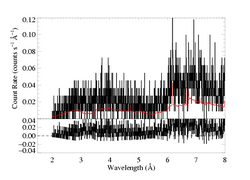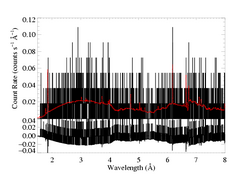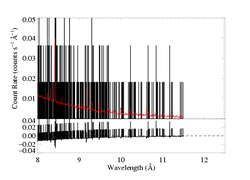Global fits
Analysis of the post-flare portion of the observation
The final 22 ks of the observation is analyzed here.
2-temperature thermal model with non-solar abundances
We use the same bapec (bapec + bapec)*wabs model we used to analyze the total observation's spectrum. We fit the MEG (top two panels below) and HEG (bottom two) simultaneously, and plot the best-fit model on the data, with the fit residuals shown below. For clarity, we break both the MEG and HEG spectra into two sections. The axis ranges are the same for the pairs of plots, and also the same we used for the total observation, to facilitate fair comparisons. Note that "+/-" uncertainties are actually 68% confidence ranges for the specified parameters.
The fit is not formally good, using chi squared with Churazov weighting. And it looks especially bad at short wavelengths in the MEG, but it's hard to tell what the problem is. Maybe this is just a reflection of the breakdown of equilibrium in the post-shock plasma. Compare these results to those from the fits to the pre-flare and flare sections.
Back to the main page.
last modified: 12 April 2009



